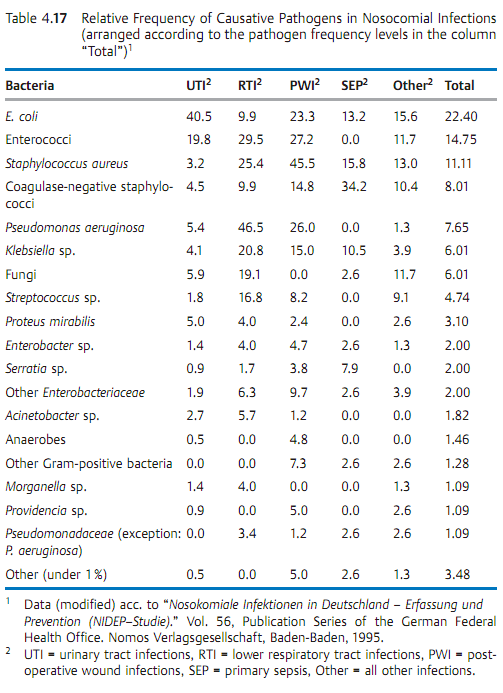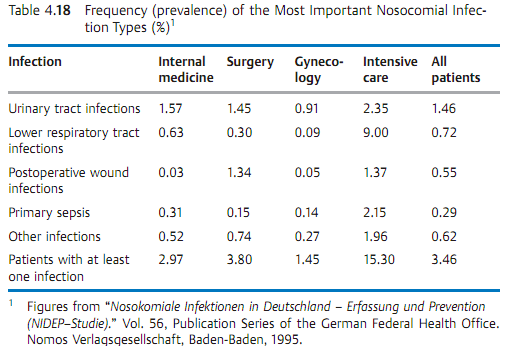


 النبات
النبات
 الحيوان
الحيوان
 الأحياء المجهرية
الأحياء المجهرية
 علم الأمراض
علم الأمراض
 التقانة الإحيائية
التقانة الإحيائية
 التقنية الحيوية المكروبية
التقنية الحيوية المكروبية
 التقنية الحياتية النانوية
التقنية الحياتية النانوية
 علم الأجنة
علم الأجنة
 الأحياء الجزيئي
الأحياء الجزيئي
 علم وظائف الأعضاء
علم وظائف الأعضاء
 الغدد
الغدد
 المضادات الحيوية
المضادات الحيوية|
Read More
Date: 7-3-2016
Date: 2025-02-06
Date: 1-3-2016
|
Nosocomial Infections
Nosocomial infections occur in hospitalized patients as complications of their primary disease. Such infections are reported in an average of approximately 3.5% (Germany) to 5% (USA) of all hospitalized patients, in tertiary care hospitals in about 10% and in the intensive care units of those in about 15-20% of cases. The most frequent types of infection are urinary tract infections (42%), pneumonia (21%), surgical wound infections (16%), and sepsis (8%). The pathogen types most frequently involved are opportunistic, Gram-negative rods, staphylococci and enterococci, followed by fungi. The bacteria are often resistant to many different antibiotics. The hands of medical staff play a major role in transmission of the infections. Control of nosocomial infections requires a number of operational measures (disinfection, asepsis, rationalized antibiotic therapies, isolation), organizational measures (hygiene committee, recognition of infections, procedural guidelines, training programs), and structural measures.
Definition
The term nosocomial infection designates infections contracted by hospitalized patients 48 hours or more from the beginning of hospitalization. These are secondary infections that occur as complications of the primary diseases to be treated in the hospital.
Pathogens, Infections, Frequency
The significance of the different human pathogens in nosocomial infections varies widely:
- Subcellular entities. Isolated cases of Creutzfeldt-Jakob disease due to unsterilized instruments have been described in the literature. Such accidents now no longer occur. There are no reliable figures available on viral nosocomial infections. A rough estimate puts viral nosocomial infections at less than 1% of the total. An example of a viral nosocomial infection is infectious hepatitis transmitted by blood or blood products.

- Bacteria are the main pathogens involved in nosocomial infections. Most of the causative organisms are facultatively pathogenic (opportunistic) bacteria, which are frequently resistant to many different antibiotics. These bacteria have found niches in which they persist as so-called hospital flora. The resistance patters seen in these bacteria reflect the often wide variations between anti-infective regimens as practiced in different hospitals.
- Fungi. Fungal nosocomial infections have been on the increase in recent years. It can be said in general that they affect immunocompromised patients and that neutropenic patients are particular susceptible.
Table 4.17 lists the pathogens that cause the most significant nosocomial infections as determined in a prevalence study done in Germany (East and West) in 1995 (NIDEP Study).
Table 4.18 shows the prevalence levels at which nosocomial infections occurred in 72 selected hospitals on a given date in the above study. The prevalence and pathogen data shown here approximate what other studies have found. Prevalence and incidence levels can vary considerably from hospital to hospital. The prevalence of nosocomial infections increases with the size of the hospital. Within a particular hospital, the infection rate is always highest in the intensive care units.

Sources of Infection, Transmission Pathways
Nosocomial infections originate either from the patient's own flora (endogenous infections) or from external sources (exogenous infections). Endogenous infections are the more frequent type. In such cases, the patient may have brought the pathogens into the hospital. It is, however, frequently the case that a patient's skin and mucosa are colonized within one to two days by bacteria of the hospital flora, which often shows multiple resistance to antibiotics and replaces the patient's individual flora, and that most endogenous infections are then actually caused by the specific hospital flora. The source of infection for exogenous infections is most likely to lie with the medical staff. In most cases, the pathogens are transmitted from patient to patient during medical and nursing activities. Less frequently, the staff is either also infected or colonized by the hospital flora. Another important cause of nosocomial infections is technical medical measures that facilitate passage of the pathogens into the body. All invasive diagnostic measures present infection risks. The patient's surroundings, i.e., the air, floor, or walls of the hospital room, are relatively unimportant as sources of infection.
Control
The measures taken to control and prevent nosocomial infections correspond in the wider sense to the general methods of infection control. The many different individual measures will not be listed here. The infection control program varies depending on the situation in each particular hospital and can be summarized in three general groups:
Operational measures. This category includes all measures pertaining to treatment and care of patients and cleaning measures. This includes asepsis, disinfection, sterilization, and cleaning. Further precautionary operational measures include isolation of patients that would be sources of infection and the economical and specific administration of antibiotic therapies.
Organizational measures. The organization of hospital infection control must be adapted to the structure of each particular hospital. Realization of the necessary measures, which of course always involve working time and expense, is best realized by establishing an infection control committee charged with the following tasks: determination and analysis of the situation, definition of measures required to improve infection control by issuing binding guidelines, cooperation in the planning and acquisition of operational and structural facilities, cooperation on functional procedures in the various sections of the hospital, contributions to staff training in matters of hospital infection control. In order to carry out these tasks efficiently, the committee should have access to a working group of specialists. In larger hospitals, a hospital epidemiologist, and staff as required, are retained for these functions.
Structural measures.
These measures refer above all to new structures, which must be built in accordance with hygienic criteria. It is therefore the obligation of the planning architect to consult experts when planning the hygienically relevant parts of a construction measure. Hygienic aspects must of course also be considered in reconstruction and restoration of older building substance.



|
|
|
|
لخفض ضغط الدم.. دراسة تحدد "تمارين مهمة"
|
|
|
|
|
|
|
طال انتظارها.. ميزة جديدة من "واتساب" تعزز الخصوصية
|
|
|
|
|
|
|
عوائل الشهداء: العتبة العباسية المقدسة سبّاقة في استذكار شهداء العراق عبر فعالياتها وأنشطتها المختلفة
|
|
|